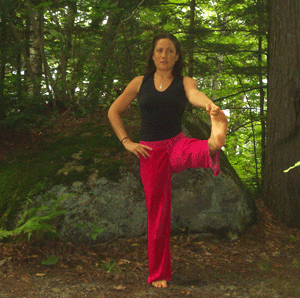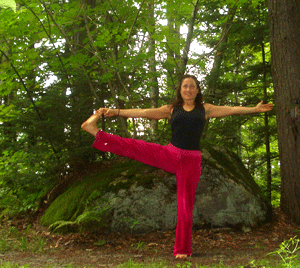 |
|
| Site Areas |
store | | | articles | | | forums | | | studios | | | vacations |
| yoga | massage | fitness | wellness | readings | ask the expert | |
Utthita Hasta PadangusthasanaYogiSource.com Staff©Yoga People, LLC 2017 Pronunciation: oo-TEET-uh HAWS-tuh POD-ung-goos-TAWS-uh-nuh Translation: In Sanskrit, Utthita means extended. Hasta means the hand. Pandangustha means big toe and asana means pose or posture. This is the Extended Hand-Toe Posture or Big Toe Hold. 
Technique: Experience the challenge of balancing on one foot with this pose which calls for strength and flexibility, building steadfastness in the practitioner. Stand in Tadasana. Shift weight onto the left foot. Extend the foot and press it firmly onto the floor. Press down with all corners of the foot and your toes. Square the hips facing forward and continue to be this way throughout the pose even when you raise your leg. Raise your right leg towards your chest by bending it at the knee. Hold your right big toe with two fingers curled around it. Rest your left hand on your left hip. On an exhalation extend the right leg so that it becomes straight while pulling the foot inwards so the extended leg moves to come in line with your torso. Gaze at a single spot on the floor about a body’s length in front of you to help with balance. Flex your foot so the toes curl back toward you. Take a couple of breaths and settle into the posture. Extend your torso, keeping as much space between sternum and pubic bone as possible. Continue to keep this “Tadasana” alignment even after one leg is in the air. That means that you should be careful to avoid collapsing on your lifted leg side. There is a tendency for the raised leg’s hip to move up towards the lower ribs. Correct this collapse by lowering the raised leg’s side hip down as you move its sit-bone towards the upper inner thigh of the standing leg. Keep the hips at the same level, parallel with the floor. If you want, you can deepen the pose by taking your foot in two hands and bringing the leg up and toward you. Really flexible yogis can bring the leg nearly straight up with the knee to the face and the hips and sit-bones parallel. As you exhale, release the hands, and lower the leg to the floor to stand in Tadasana pose again. Repeat the pose on the other side.
Additional variation: The pose can be done with the leg extended to the side of the body. This variation has several names. It is called Parsva Utthita Hasta Padangusthasana, Utthita Parsvasahita and even Utthita Hasta Padangushthasana II by other practitioners. The pose involves bringing your foot to the the side with an extended leg while balancing on the other foot. Open your right hip by bringing your leg out to the right. Extend the left arm out to the side so it is parallel to the ground. If you are flexible, draw the right foot towards your head by using your arm muscles as your hips stay level. In this variation it is also important to keep the side hips and sitbones aligned. As in the main pose this alignment is facilitated by bringing the sit-bone of the raised leg down towards the inner upper thigh of the straight leg. The head may face to the side in the opposite direction or straight forward. Beginners Tips: Try using a yoga strap looped around the foot and held with one hand. The strap will extend the reach of your arm which will make this pose accessible to everyone. If balance is difficult, try the following: Make sure your practice space is firm, level surface. Use a prop of an elevated surface to support the lifted foot during the pose. Possible props include a dancer’s bar, a “pune pony”, a stair banister or a window ledge. Position yourself so that the standing leg is perpendicular to the floor and the hips aligned facing the prop as the heel of the extended raised leg is supported by the prop. As you acquire better balance you won’t need these props. Benefits: This is one of a short list of standing poses that are said to be good to do during menstruation by Geeta Iyengar. This posture is suggested by some for pregnancy especially for the second and third trimesters. It is suggested that one does a supported version against the wall or on a ledge. Some yogis recommend this pose in pregnancy only if it was being practiced unsupported before pregnancy. When the belly gets big and in the way, do the variation with the leg extended to the side. The pose strengthens and stretches the inner and back legs and the spine. It also improves balance and coordination. Contraindications and Caution: Do not do the pose if you have a recent or chronic injury to the legs, arms or shoulders. Be cautious of your hamstrings to not overstretch them in this pose. Consult with your yoga teacher and health care provider if you are pregnant and want to do the pose. Work with a teacher who is experienced with pregnant students. Always listen to your body and notice messages that it gives you as you do yoga. Thanks to Victor Oppenheimer for his editing and expertise in creating this article. All Rights Reserved Copyright 2006 |
| about us | contact | privacy | site map | careers | |

|
|
